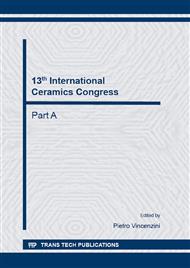[1]
P.G. Harrison, N.C. Lloyd, W. Daniell, C. Bailey, W. Azelee, Evolution of microstructure during the thermal activation of chromium-promoted tin(IV) oxide catalysts: An FT-IR, FT-Raman, XRD, TEM, and XANES/EXAFS study, Chemistry of Materials 11 (4) (1999).
DOI: 10.1021/cm980347p
Google Scholar
[2]
P.G. Harrison, N.C. Lloyd, W. Daniell, I.K. Ball, C. Bailey, W. Azelee, Evolution of microstructure during the thermal activation of copper(II) and chromium(III) doubly promoted tin(IV) oxide catalysts: An FT-IR, XRD, TEM, XANES/EXAFS, and XPS study, Chemistry of Materials 12 (10) (2000).
DOI: 10.1021/cm001126y
Google Scholar
[3]
P.G. Harrison, N.C. Lloyd, W. Daniell, The nature of the chromium species formed during the thermal activation of chromium-promoted tin(IV) oxide catalysts: An EPR and XPS study, J. Phys. Chem. B 102 (52) (1998) 10672-10679.
DOI: 10.1021/jp9822135
Google Scholar
[4]
R.H.R. Castro, J. Rufner, P. Hidalgo, D. Gouvea, J.A.H. Coaquira, K. van Benthem, Surface Segregation in Chromium-Doped Nanocrystalline Tin Dioxide Pigments, Journal of the American Ceramic Society 95 (1) (2012) 170-176.
DOI: 10.1111/j.1551-2916.2011.04868.x
Google Scholar
[5]
M. Kato, H. Unuma, M. Takakashi, Color modification of chromium-tin pink pigment by substitution of Ti for Sn, Journal of the Ceramic Society of Japan 108 (5) (2000) 478-481.
DOI: 10.2109/jcersj.108.1257_478
Google Scholar
[6]
E. Lopez-Navarrete, A.R. Gonzalez-Elipe, M. Ocana, Non-conventional synthesis of Cr-doped SnO2 pigments, Ceramics International 29 (4) (2003) 385-392.
DOI: 10.1016/s0272-8842(02)00149-9
Google Scholar
[7]
L. Jiang, P.J. Wang, C.W. Zhang, X.Y. Feng, Y. Lu, G.L. Zhang, Electronic structure and optical properties of Cr doped SnO2 superlattice, Acta Physica Sinica 60 (9) (2011).
DOI: 10.7498/aps.60.093101
Google Scholar
[8]
M.A. Tena, S. Meseguer, C. Gargori, A. Fores, J.A. Badenes, G. Monros, Study of Cr-SnO2 ceramic pigment and of Ti/Sn ratio on formation and coloration of these materials, Journal of the European Ceramic Society 27 (1) (2007) 215-221.
DOI: 10.1016/j.jeurceramsoc.2006.04.183
Google Scholar
[9]
E. Lopez-Navarrete, A. Caballero, V.M. Orera, F.J. Lazaro, M. Ocana, Oxidation state and localization of chromium ions in Cr-doped cassiterite and Cr-doped malayaite, Acta Materialia 51 (8) (2003) 2371-2381.
DOI: 10.1016/s1359-6454(03)00044-2
Google Scholar
[10]
F. Solymosi, J. Kiss, ADSORPTION AND REDUCTION OF NO ON TIN(IV) OXIDE DOPED WITH CHROMIUM(III) OXIDE, Journal of Catalysis 54 (1) (1978) 42-51.
DOI: 10.1016/0021-9517(78)90025-8
Google Scholar
[11]
C.N. Xu, J. Tamaki, N. Miura, N. Yamazoe, Stabilization of SnO2 Ultrafine Particles by Additives, J Mater Sci 27 (4) (1992) 963-971.
DOI: 10.1007/bf01197649
Google Scholar
[12]
D. Szczuko, J. Werner, S. Oswald, G. Behr, K. Wetzig, XPS investigations of surface segregation of doping elements in SnO2, Applied Surface Science 179 (1-4) (2001) 301-306.
DOI: 10.1016/s0169-4332(01)00298-7
Google Scholar
[13]
R.H.R. Castro, P. Hidalgo, R. Muccillo, D. Gouvea, Microstructure and structure of NiO-SnO2 and Fe2O3-SnO2 systems, Appl. Surf. Sci. 214 (1-4) (2003) 172-177.
DOI: 10.1016/s0169-4332(03)00274-5
Google Scholar
[14]
D. Gouvea, G.J. Pereira, L. Gengembre, M.C. Steil, P. Roussel, A. Rubbens, P. Hidalgo, R.H.R. Castro, Quantification of MgO surface excess on the SnO2 nanoparticles and relationship with nanostability and growth, Appl Surf Sci 257 (9) (2011).
DOI: 10.1016/j.apsusc.2014.05.017
Google Scholar
[15]
P.A. Lessing, Mixed-Cation Oxide Powders Via Polymeric Precursors, Am Ceram Soc Bull 68 (5) (1989) 1002-1007.
Google Scholar
[16]
M.P. Pechini (Sprague Electric Co), (1967).
Google Scholar
[17]
D. Gouvea, A. Smith, J.P. Bonnet, Manganese segregation on the surface of SnO2 based powders, Eur. J. Solid State Inorg. Chem. 33 (10) (1996) 1015-1023.
Google Scholar
[18]
G.J. Pereira, R.H.R. Castro, P. Hidalgo, D. Gouvea, Surface segregation of additives on SnO2 based powders and their relationship with macroscopic properties, Appl. Surf. Sci. 195 (1-4) (2002) 277-283.
DOI: 10.1016/s0169-4332(02)00567-6
Google Scholar
[19]
D. Gouvêa, G.J. Pereira, L. Gengembre, M.C. Steil, P. Roussel, A. Rubbens, P. Hidalgo, R.H.R. Castro, Quantification of MgO surface excess on the SnO2 nanoparticles and relationship with nanostability and growth, Appl. Surf. Sci. 257 (9) (2011).
DOI: 10.1016/j.apsusc.2014.05.017
Google Scholar
[20]
J.H. Wang, G.H. Peng, Y.Z. Guo, X.K. Yang, XPS investigation of segregation of sb in SnO2 powders, Journal of Wuhan University of Technology-Materials Science Edition 23 (1) (2008) 95-99.
DOI: 10.1007/s11595-006-1095-9
Google Scholar
[21]
S. Oswald, G. Behr, D. Dobler, J. Werner, K. Wetzig, W. Arabczyk, Specific properties of fine SnO2 powders connected with surface segregation, Analytical and Bioanalytical Chemistry 378 (2) (2004) 411-415.
DOI: 10.1007/s00216-003-2277-3
Google Scholar
[22]
J.P. Bonnet, N. Dolet, J.M. Heintz, Low-temperature sintering of 0. 99 SnO2 0. 01 CuO: Influence of copper surface diffusion, Journal of the European Ceramic Society 16 (11) (1996) 1163-1169.
DOI: 10.1016/0955-2219(96)00046-5
Google Scholar
[23]
J. Nowotny, INTERFACE DEFECT CHEMISTRY OF OXIDE CERAMIC MATERIALS - UNRESOLVED PROBLEMS, Solid State Ionics 49 (1991) 119-128.
DOI: 10.1016/0167-2738(91)90077-o
Google Scholar
[24]
D. Cordischi, D. Gazzoli, M. Occhiuzzi, M. Valigi, Redox behavior of VIB transition metal ions in rutile TiO2 solid solutions: An XRD and EPR study, J. Solid State Chem. 152 (2) (2000) 412-420.
DOI: 10.1006/jssc.2000.8698
Google Scholar
[25]
F. Brito, J. Ascanio, S. Mateo, C. Hernandez, L. Araujo, P. Gili, P. MartinZarza, S. Dominguez, A. Mederos, Equilibria of chromate(VI) species in acid medium and ab initio studies of these species, Polyhedron 16 (21) (1997) 3835-3846.
DOI: 10.1016/s0277-5387(97)00128-9
Google Scholar


